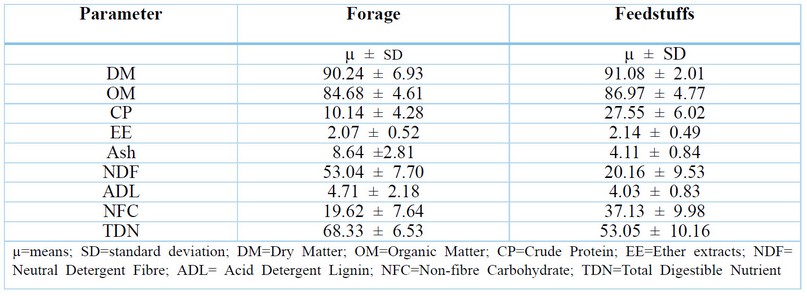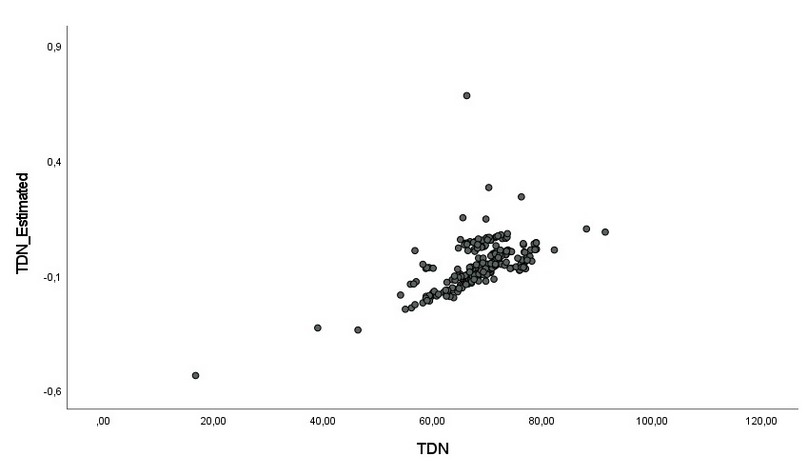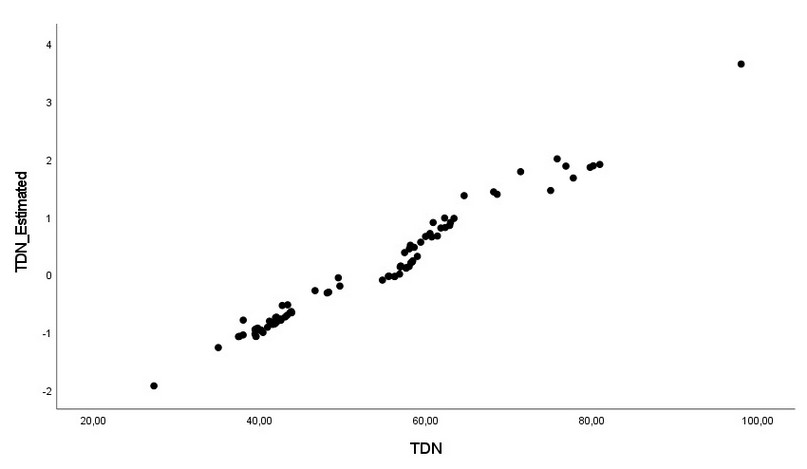2023.08.04.23
Files > Volume 8 > Vol 8 no 4 2023
Prediction Total Digestible Nutrient value of forage and feedstuffs from their chemical characteristics

1 Institute for Animal Production System in Mediterranean Environment, National Research Council, P. le E. Fermi 1, 80055, Portici, Italy.
2 Institute for Animal Production System in Mediterranean Environment, National Research Council, P. le E. Fermi 1, 80055, Portici, Italy; [email protected].
3 Institute for Animal Production System in Mediterranean Environment, National Research Council, P. le E. Fermi 1, 80055, Portici, Italy; [email protected].
4 Institute for Animal Production System in Mediterranean Environment, National Research Council, P. le E. Fermi 1, 80055, Portici, Italy; [email protected].
* Correspondence: [email protected]
Available from. http://dx.doi.org/10.21931/RB/2023.08.04.23
Total Digestible Nutrient Value of forage and concentrate and nutritional characteristics and develop a prediction equation using the chemical composition variables as predictors. Nutrient chemical characteristics data were obtained from 278 forage and 87 feedstuffs. The data included dry and organic matter, crude protein, ether extract, ash, fiber composition, and non-fiber Carbohydrate. Stepwise regression was used to eliminate variables that did not influence variation in the model and used 0.05 as the critical probability level.
Data were then randomly divided into two parts; two-thirds of the data was used to estimate the Total Digestible Nutrient, whereas the remaining part was used to validate the estimated Total Digestible Nutrient and was analyzed by multiple linear regressions. Total Digestible Nutrient in forage was negatively correlated with Ether Extract, Acid Detergent Lignin, and Non-fibre Carbohydrate (P<0.01) but positively correlated with Crude Protein (P<0.01), ash, Neutral Detergent Fibre, and Acid Detergent Fiber. Total Digestible Nutrient in feedstuffs was negatively correlated with NFC (P<0.01) but positively correlated with Neutral Detergent Fibre (P<0.01), Acid Detergent Lignin (P<0.01), Ether Extract (P<0.01), Crude Protein (P<0.01), ash, and Acid Detergent Fiber (P<0.01). The results show that the Total Digestible Nutrient content can be accurately estimated starting from the chemical composition.
Keywords: total digestible nutrient; forage; concentrate; feed analysis.
INTRODUCTION
The available energy in feedstuff represents the most significant proportion of the total cost of ruminant production. Furthermore, the improved nutrient utilization efficiency is strongly related to enhanced economic performance and reduced environmental impact of farms.
The provision of energy for livestock is performed through feedstuff, and it substantially determines the production level. The primary nutrients that contribute to energy are carbohydrates, lipids, and protein1.
The energy present in feeds is called gross energy (GE), but it does not reflect to which extent the energy is available for animals. To overcome such weaknesses, other energy measures are digestible energy (DE), metabolizable energy (ME), and net energy (NE).
Another critical measurement energy system has been developed: the total digestible nutrient (TDN); its value represents the utilizable energy content of a feedstuff, and 2 equations calculate it.
Traditionally, TDN is utilized as the base for estimating the NE content of feedstuff and diets.
For example, TDN levels of concentrates affect average daily gain (ADG) and intramuscular fat deposition of fattening cattle3. Therefore, it is essential to produce high-quality meat from steers. 4. Over the past 25 years, improving cow productivity has also required increased nutrient requirements, making it challenging to meet the demands of high-yielding cows by grazing alone.
In Korea, studies have been undertaken on shortening the fattening period and appropriate slaughter age to reduce feed costs and decrease the production of inedible fat8-9. Additionally, studies have been conducted about increasing the TDN level of concentrates to maintain the marbling score while shortening the fattening period, which has been 10-11. The papers reported that increasing the TDN levels in concentrate has improved the dry matter (DM) digestibility, energy availability, ADG, and meat quality grade12-13-14; however, feeding excessively high TDN concentrate may lead to deposition of inedible fat and cause metabolic diseases15.
The present study aimed to investigate the relationship between the chemical characteristics of forage and concentrate and develop a prediction equation using the chemical composition variables as predictors.
MATERIALS AND METHODS
Nutrient chemical characteristics data were obtained from 278 forage and 87 feedstuffs.
The chemical compositions of the experimental feed were analyzed following the standard methods of the16, neutral detergent fiber (NDF) and Lignin (ADL) were analyzed based on methods described by17, and TDN was analyzed and evaluated following the method described by2.
Non-fibre Carbohydrate (NFC) is calculated as OM-(NDF+EE+CP).
The chemical composition and nutritional value of the feedstuffs are shown in Table 1.

Table 1. Summary (means ± standard deviation) of chemical composition (% DM) of forage
(n=278) and feedstuffs (n=87) used in the database
Statistical analysis was performed using 18. Multiple linear regressions analyzed the data to evaluate the relationship between TDN and various predictor variables. Stepwise regression was used to eliminate variables that did not influence variation in the model and used 0.05 as the critical probability level.
The correlation was performed between chemical composition and TDN for both forage and feedstuffs (Tables 2 and 3). The significance was indicated by * and ** for P<0.05 and P<0.01, respectively.
Data were then randomly divided into two parts; two-thirds was used to estimate TDN, whereas the remaining data was used to validate the estimated TDN.
The standard error of prediction was used to judge the predictive ability of a calibration equation. Equation validation was conducted to assess the predictive ability of the selected calibration equation.
Validation entails predicting an independent set of samples, i.e., from a different population than the calibration set, with known reference values, or removing a certain number of samples from the calibration set and not using them in the calibration process.
The study found significant coefficients between forage chemical composition and nutrient digestibility, specifically for CP (0.993 with p<0.01) and NFC (-0.994 with p<0.01).
Regarding feed, the correlation coefficients were significant for all parameters except dry matter.
The results were as follows: NDF (0.703 p<0.01); ADL (0464 p<0.01); NFC (-0.952 p<0.01); EE (0.657 p<0.01); CP (0.373 p<0.01); ADF (0.685 p<0.01).
Similar results were reported by 19.
High correlation values represent more excellent agreement but not necessarily greater accuracy for estimating the means.
In Table 2, we report the results of ANOVA for the regression model considered for predicting TDN in forage.
Examination of the table shows the goodness of the forecast model chosen, as highlighted by the low value of the residue.

Table 2. ANOVA for the regression model of forage.
Using NFC, CP, EE may be predicted by the following equation (1):
TDNforage=70.41-0.546NFC+0.453CP+0.04EE ± error (1)
Relatively similar coefficients between NFC and CP to estimated TDN in forage confirm the similarity of energetic values between starch and protein20. (Figure 1)

Figure 1. Values of estimated and observed TDN in forage were reported, indicating the validity of the prediction equation.
In Table 3, we report the result of ANOVA for the regression model considered for predicting TDN in feedstuffs. Examination of the table shows the goodness of the forecast model chosen, as highlighted by the low value of the residue.

Table 3. ANOVA for the regression model of feedstuffs.
Using NFC and EE may be predicted by the following equation (2):
TDNfeedstuffs=86.76-0.822NFC+0.291EE ± error (2)
These prediction equations were entirely accurate, as indicated by the high values of R2. The non-significant correlation of TDN with NDF for forage and the absence of this parameter in predictive equations may indicate a lower contribution to the energy available for livestock; this may be related to the negative effect of NDF, particularly lignocellulose component, on ruminal degradation and total tract digestibility21-22.
The low EE coefficient in the prediction equation for both fodder and feedstuffs is probably linked to lipids generating less energy than starch and proteins.
This result contrasts with what was reported by 23 in the study on dairy calves. (Figure 2)

Figure 2. Estimated and observed TDN values in feedstuffs indicate the prediction equation's validity.
If you want to estimate the TDM content of a unified, as suggested by 24, it is necessary to know precisely the forage/feedstuffs ratio (F:f) to obtain the TDN value of the diet. For example, a unified with a Forage: feedstuffs ratio of 60:40, its TDN equation could be (3):
TDNunifeed = (0.6 TDMforage) + (0.4 TDMfeedstuffs) (3)
The impact of interactions between feed components on TDN is essential, and the continuous need to deepen our understanding of energy and metabolism concepts is evident. Building upon this, the results of this preliminary study underscore that the TDN content, whether in forages or feedstuffs, can be precisely estimated based on the chemical composition of the diet-administered foods. This contribution to the field enhances our grasp of the intricate relationships between feed composition and TDN levels, empowering accurate predictions. These findings are significant as they provide valuable insights for crafting optimal livestock diets that enhance agricultural enterprises' economic performance and environmental sustainability.
Author Contributions: Fiorella Sarubbi: Conceptualization, Methodology, Software, Writing- Original draft preparation. Giuseppe Auriemma: Visualization, Investigation, Writing- Original draft preparation. Raffaele Pappalardo: Visualization, Investigation, Writing- Original draft preparation. Giuseppe Grazioli: Visualization, Investigation, Writing- Original draft preparation.
Funding: This research received no external funding.
Institutional Review Board Statement: Not applicable.
Conflicts of Interest: The authors declare no conflict of interest.
1 Hall, M.B.; Eastrige, M.L. Carbohydrate and fat: Considerations for energy and more. Prof. Anim. Sci. 2014. 30, 140-149
2 Nutrient requirement of dairy cattle. 7th ed. National Academy Press, Washington, DC, USA. 2001. DOI: 10.17226/9825
3 Jeong, J.; Seong, NI; Hwang, I.K.; Lee, S.B.; Yu, M.S.; Nam, I.S.; Lee, M.I. Effects of level of CP and TDN in the concentrate supplement on growth performances and carcass characteristics in Hanwoo steers during final fattening period. J Anim Sci Technol. 2010. 52, 305-312
4 Lee, C.R. Effects of energy-enriched concentrate on growth performance and carcass characteristics of Hanowoo strees. M.S. thesis, Kyungpook National University, Sangju, Korea. 2017
5 Waghorn, GC; Clark, D.A. Feeding value of pastures for ruminants. NZ. Vet. Journal. 2004.52, 320-331
6 Ferris, C. Sustainable pasture-based dairy system- Meeting the challenges. Can. J. Plant Sci. 2007. 87, 723-738
7 Phuong, H.N.; Friggens N.C.; de Boer, I.J.M.; Schmidely P. Factors affecting energy and nitrogen efficiency of dairy cows: A meta-analysis. J. Dairy Sci. 2013. 96, 7245-7259.
8 Hong, B.C. Analyses of optimal feeding period to improve productivity for Hanwoo cattle farm. Ph.D. dissertation, Kangwon National Univ., Chuncheon, Korea 2016.
9 Yoon, J.H.; Won, JI; Lee, K.S.; Kim, J.B.; Lee, J.K. Estimation of reasonable marked month of age for Hanwoo steer. J. Anim. Sci. Technol. 2013. 55:405-416
10 Chung, K.Y.; Lee, S.H.; Cho, S.H.; Kwon, E.G.; Lee, J.H. Current situation and prospects for beef production in South Korea-A review. Asian-Australias J. Anim Sci. 2018. 31, 951-960
11 Lee, S.M.; Chang, S.S.; Jung, K.Y.; Kim, H.C.; Choi, S.H.; Kwon, E.G.; Park B.K.; Yang, B.S.; Lee, S.S.; Cho, Y.M. Effect of feeding patterns of concentrate on growth performance, blood parameters and carcass characteristics in fattening Honwoo cows. J. Animal Sci Technol. 2013. 55, 33-39.
12 Chung, K.Y.; Chung, S.S.; Lee, E.M.; Kim, H.J.; Park, B.H.; Kwon, E.G. Effects of high energy diet on growth performance, carcass characteristics, and blood constituents of final fattening Hanwoo sters. Korean. J Agric Sci., 2015. 42,261-268
13 Hwang, J.A.; Islam, M.M.; Ahmed, S.T.; Mun, H.S.; Kim, G.M.; Kim, Y.J.; Yang C.J. (Seamustard (Undaria pinnatifida) improves growth, immunity, fatty acid profile and reduces cholesterol in Hanwoo steers. Asian-Australas J Anim Sci. 2014. 27, 1114-1123.
14 Ki, K.S; Lim, Y.S.; Jin, Z.L.; Lee, H.J.; Kim, S.B.; Lee, W.S.; Yang, S.H.; Cho, W.M.; Kim, H.S.; Jeo, J.M.; Lee, I.D. Effect of crude protein and total digestible nutrient levels on intake, digestibility, nitrogen and energy utilization in growing dairy goats. J Korean Soc Grassl Forage Sci, 2009. 29,269-276.
15 Rossi, C.A.S.; Compiani, R. Ruminal acidosis of beef cattle and related diseases. Large Anim Rev 2016. 22, 273-279.
16 Association of Official Analytical Chemists [AOAC]. Official methods of analysis of AOAC international. 18th ed. AOAC International, Gaithersburg, MD, USA. 2005.
17 Van Soest, P.J.; Robertson, J.B.; Lewis, B.A. Methods for dietary fiber, neutral detergent fiber, and nonstarch polysaccharides in relation to animal nutrition. J Dairy Sci. 1991.74(10):3583-97
18 Statistical Package for the Social Sciences - SPSS®. ver. 24.0. SPSS Inc. Chicago, IL, USA. 2017.
19 Morrison, F.B. Feed and Feeding, Abridged. 9th ed. Morrison Publ. C., Clinton, IA 1961.
20 Gallardo, C.; Dadalt, J.C.;Neto, M.A.T. Nitrogen retention, energy, and amino acid digestibility of wheat bran, without or with multicarbvohydrate and phytase supplementationb, fed to broiler chickens. J. of Anim. Sci. 2018. 96, 2371-2379
21 Riaz, M.Q.; Südekum, K.H.; Clauss M.; Jayanegara, A. Volontary feed intake and digestibility of four domestic ruminant species as influenced by dietary consitituent: A metaanalysis. Livest. Sci. 2014. 162, 76-85
22 Harahap, R.P.; Jayanegara, A.; Nahrowi; Fakhri S. Evaluation of oil palm fronds using fiber-cracking technology combined with Indigofera sp. In ruminant ration by Rusitec. AIP Conference Proceeding 2021: art. No. 050008
23 Ghasemi, E.; Azad-Shahraki, M.; Khorvash, M. Effect of different fat supplement on performance of dairy calvews during cold season. Jornal of dairy science, 2017. 100, 5319-5328
24 Jayanegara, A.; Ridla, M.; Nahrowi Laconi, E.B. Estimation and validation of total digestible nutrient values of forage and concentrate feedstuffs. 9th Annual Basic Science International Conference, IOP Conf. Series: Materials Science and Engineering 2019.
Received: 28 September 2023/ Accepted: 15 November 2023 / Published:15 December 2023
Citación: Sarubbi F, Auriemma G, Pappalardo R, Grazioli G, Prediction Total Digestible Nutrient value of forage and feedstuffs from their chemical characteristics. Revis Bionatura 2023;8 (4) 23. http://dx.doi.org/10.21931/RB/2023.08.04.23